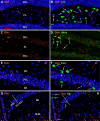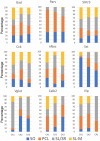Characterization of Oxytocin Receptor Expression Within Various Neuronal Populations of the Mouse Dorsal Hippocampus
- PMID: 32256314
- PMCID: PMC7093644
- DOI: 10.3389/fnmol.2020.00040
Characterization of Oxytocin Receptor Expression Within Various Neuronal Populations of the Mouse Dorsal Hippocampus
Abstract
Oxytocin, acting through the oxytocin receptor (Oxtr) in the periphery, is best known for its roles in regulating parturition and lactation. However, it is also now known to possess a number of important social functions within the central nervous system, including social preference, memory and aggression, that vary to different degrees in different species. The Oxtr is found in both excitatory and inhibitory neurons within the brain and research is focusing on how, for example, activation of the receptor in interneurons can enhance the signal-to-noise of neuronal transmission. It is important to understand which neurons in the mouse dorsal hippocampus might be activated during memory formation. Therefore, we examined the colocalization of transcripts in over 5,000 neurons for Oxtr with those for nine different markers often found in interneurons using hairpin chain reaction in situ hybridization on hippocampal sections. Most pyramidal cell neurons of CA2 and many in the CA3 express Oxtr. Outside of those excitatory neurons, over 90% of Oxtr-expressing neurons co-express glutamic acid decarboxylase-1 (Gad-1) with progressively decreasing numbers of co-expressing cholecystokinin, somatostatin, parvalbumin, neuronal nitric oxide synthase, the serotonin 3a receptor, the vesicular glutamate transporter 3, calbindin 2 (calretinin), and vasoactive intestinal polypeptide neurons. Distributions were analyzed within hippocampal layers and regions as well. These findings indicate that Oxtr activation will modulate the activity of ~30% of the Gad-1 interneurons and the majority of the diverse population of those, mostly, interneuron types specifically examined in the mouse hippocampus.
Keywords: calbindin; cholecystokinin; cornu ammonis 2; glutamic acid decarboxylase; hairpin chain reaction; nitric oxide synthase; parvalbumin; somatostatin.
Copyright © 2020 Young and Song.
Figures













Similar articles
-
Conditional Deletion of Hippocampal CA2/CA3a Oxytocin Receptors Impairs the Persistence of Long-Term Social Recognition Memory in Mice.J Neurosci. 2018 Jan 31;38(5):1218-1231. doi: 10.1523/JNEUROSCI.1896-17.2017. Epub 2017 Dec 26. J Neurosci. 2018. PMID: 29279308 Free PMC article.
-
Distribution of nonprincipal neurons in the rat hippocampus, with special reference to their dorsoventral difference.Brain Res. 1997 Mar 14;751(1):64-80. doi: 10.1016/s0006-8993(96)01395-9. Brain Res. 1997. PMID: 9098569
-
Substance P receptor expression by inhibitory interneurons of the rat hippocampus: enhanced detection using improved immunocytochemical methods for the preservation and colocalization of GABA and other neuronal markers.J Comp Neurol. 2001 Feb 12;430(3):283-305. J Comp Neurol. 2001. PMID: 11169468
-
The oxytocin receptor represents a key hub in the GPCR heteroreceptor network: potential relevance for brain and behavior.Front Mol Neurosci. 2022 Dec 8;15:1055344. doi: 10.3389/fnmol.2022.1055344. eCollection 2022. Front Mol Neurosci. 2022. PMID: 36618821 Free PMC article. Review.
-
Cellular architecture of the mouse hippocampus: a quantitative aspect of chemically defined GABAergic neurons with stereology.Neurosci Res. 2006 Nov;56(3):229-45. doi: 10.1016/j.neures.2006.07.007. Epub 2006 Aug 22. Neurosci Res. 2006. PMID: 16930755 Review.
Cited by
-
Social odors drive hippocampal CA2 place cell responses to social stimuli.Prog Neurobiol. 2025 Feb;245:102708. doi: 10.1016/j.pneurobio.2024.102708. Epub 2024 Dec 30. Prog Neurobiol. 2025. PMID: 39743170 Free PMC article.
-
Social odors drive hippocampal CA2 place cell responses to social stimuli.bioRxiv [Preprint]. 2024 Sep 19:2024.07.16.603738. doi: 10.1101/2024.07.16.603738. bioRxiv. 2024. Update in: Prog Neurobiol. 2025 Feb;245:102708. doi: 10.1016/j.pneurobio.2024.102708. PMID: 39071428 Free PMC article. Updated. Preprint.
-
Spatiotemporal Mapping of the Oxytocin Receptor at Single-Cell Resolution in the Postnatally Developing Mouse Brain.Neurosci Bull. 2025 Feb;41(2):224-242. doi: 10.1007/s12264-024-01296-x. Epub 2024 Sep 15. Neurosci Bull. 2025. PMID: 39277552 Free PMC article.
-
Altered PVN-to-CA2 hippocampal oxytocin pathway and reduced number of oxytocin-receptor expressing astrocytes in heart failure rats.J Neuroendocrinol. 2022 Jul;34(7):e13166. doi: 10.1111/jne.13166. Epub 2022 Jun 3. J Neuroendocrinol. 2022. PMID: 35657290 Free PMC article.
-
Complexity of the Hypothalamic Oxytocin System and its Involvement in Brain Functions and Diseases.Neurosci Bull. 2025 Jul;41(7):1267-1288. doi: 10.1007/s12264-025-01424-1. Epub 2025 May 30. Neurosci Bull. 2025. PMID: 40445489 Review.
References
Grants and funding
LinkOut - more resources
Full Text Sources
Miscellaneous

